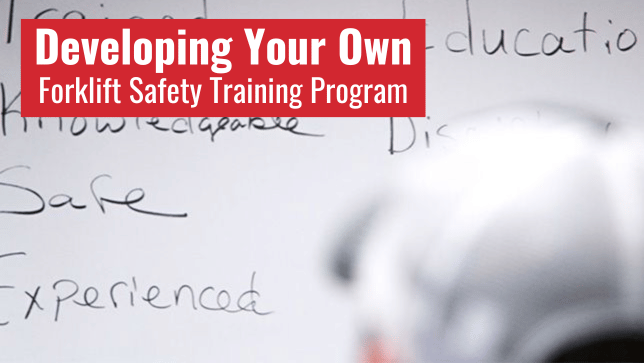Instead of hiring an outside contractor to conduct training classes, many companies opt to manage safety procedures and training in-house.
Depending on your company’s needs, having dedicated safety and training personnel may be more convenient than scheduling sessions with an external trainer.
However, ensuring that in-house trainers are knowledgeable, skilled, and compliant with OSHA standards can be challenging.
A successful forklift safety training program addresses all these factors and ensures workplace safety.
Let’s dive in
Successful Programs Meet OSHA’s Recommended Practices
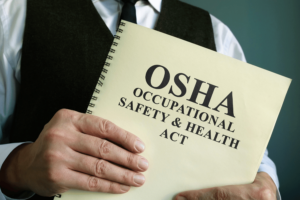
To align their training programs with OSHA’s recommended practices, many organizations send their trainers to specialized Train-The-Trainer classes.
These classes equip trainers with the skills and knowledge to deliver essential safety guidelines clearly and effectively, but knowledgeable trainers alone don’t guarantee a successful safety training program.
It’s essential to evaluate every aspect of your facility to identify areas that need improvement.
Keeping equipment up-to-date and ensuring all employees—from machine operators to on-foot personnel—understand their roles is critical.
Including everyone in safety planning helps create a comprehensive safety program that protects workers and company property.
To help you get started, here’s an OSHA-recommended checklist for developing your program:
1. Identify the Equipment in Your Workplace
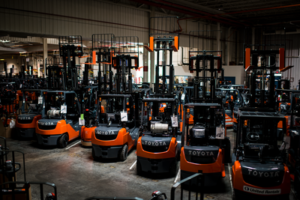
Your operators need training on every type of equipment they use.
Start by identifying all the equipment currently in operation at your facility.
This includes familiarizing operators with various types of forklifts and their controls to ensure safe operation.
Key aspects of equipment familiarization include:
- Understanding the features and functions of powered industrial trucks, including the forces that can cause tip overs and how to avoid them.
- Learning about truck design considerations, such as the “stability triangle,” and safety ratings.
- Conducting pre-operational checkouts using a standardized checklist and knowing the steps to take if issues arise.
- Mastering safe operating procedures for raising and lowering loads, maneuvering in aisles, and operating on inclines.
- Ensuring proper protocols are followed for battery changing, charging, and maintenance, as well as refueling internal combustion vehicles.
2. Evaluate your Facility’s Hazards
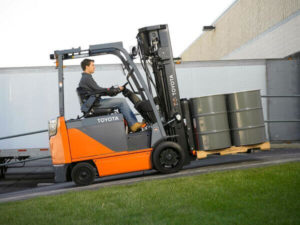
Assess your facility for potential hazards, such as blind corners, inclines, high-traffic intersections, and loading docks.
Review and reinforce the safety procedures specific to these areas to reduce the potential for serious injury.
Incorporate risk assessments to address workplace conditions and identify safety concerns, such as limited visibility or high pedestrian traffic, that could increase the likelihood of accidents.
Ensure operators understand the unique challenges of the facility’s layout and are trained on navigating powered industrial trucks (PITs) safely in these environments.
Providing clear guidance on safety compliance helps build a safer work environment for everyone.
3. Establish your Training Methods

Decide how and when your operators and pedestrians will receive training.
Ensure your methods combine in-class instruction with practical, hands-on training.
Hands-on sessions should provide operators with opportunities to practice driving and handling loads under supervision in a controlled environment.
Incorporate group discussions, videos, and live demonstrations to reinforce key concepts.
During these sessions, emphasize the importance of pre-operational checkouts, including using an inspection checklist to confirm equipment readiness.
Tailor the training to specific truck types and workplace conditions to ensure relevance and effectiveness.
Supervisors should monitor and guide operators as they practice essential tasks, such as material handling, navigating tight spaces, and raising and lowering loads safely.
By simulating real-world scenarios, these practical training sessions build confidence and proficiency, preparing operators to handle powered industrial trucks safely and efficiently in their specific work environments.
4. Create your Training Program Content

Your training should ensure operators are confident in using the equipment they’ll handle.
Cover essential procedures, including:
- Loading and Unloading: Train operators on proper load handling techniques, ensuring they understand load limits, balance, and securing methods to avoid spills or accidents.
- Operating on Inclines: Provide clear instructions on maintaining control of the forklift on slopes, including tips on driving up and down inclines safely.
- Battery Charging: Teach operators the correct methods for charging and changing batteries, emphasizing the importance of safety measures to prevent accidents or damage to equipment.
- Replacing LP Tanks: Demonstrate proper steps for safely removing and replacing LP tanks, including checking for leaks and securely fastening the tank.
Additionally, emphasize the Operator’s Responsibilities in maintaining a safe workplace, such as:
- Acquiring knowledge and skills required to handle equipment properly.
- Ensuring load lifting safety by assessing weight distribution and environmental factors.
- Performing pre-operational checkouts to confirm equipment functionality and safety compliance.
- Reporting any issues or hazards to supervisors promptly.
Finally, train pedestrians on safety protocols for working around forklifts, such as maintaining a safe distance, recognizing forklift blind spots, and adhering to designated walkways.
5. Determine a Valid Employee Evaluation
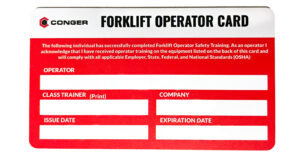
Many evaluations include a written test combined with a visual evaluation to assess operators’ understanding and skills effectively.
Start with a written exam that covers critical topics such as equipment functionality, maintenance protocols, safety standards, and risk assessment.
Follow this with a hands-on evaluation to ensure operators can demonstrate their skills in real-world scenarios, including pre-operational checkouts, safe operating procedures, and adherence to safety compliance measures.
6. Develop a Documentation System

As the employer, you’re responsible for certifying that your operators have been trained and evaluated, so create a system to document and track this information.
Once operators successfully complete written tests with hands-on evaluations, document their performance and provide formal certification.
The certification process should include detailed records of the training modules completed, evaluation results, and any additional safety courses attended.
Regularly review and update certification requirements to reflect changes in safety standards and workplace conditions, ensuring continued competency and compliance.
7. Prepare Refresher Training

Plan for refresher training in cases such as workplace incidents or changes in facility conditions. Regular updates ensure ongoing compliance and safety.
By following these steps, you can build an effective forklift safety training program that meets OSHA standards and enhances workplace safety and efficiency.
For more detailed guidance, check out our complete guide to forklift operator and pedestrian safety training.
Need help developing your program?
Visit Conger for a comprehensive Train-The-Trainer program. Conger offers online and in-person classes at your facility and has offices in Green Bay, Neenah, Wausau, Richfield, and Madison.
